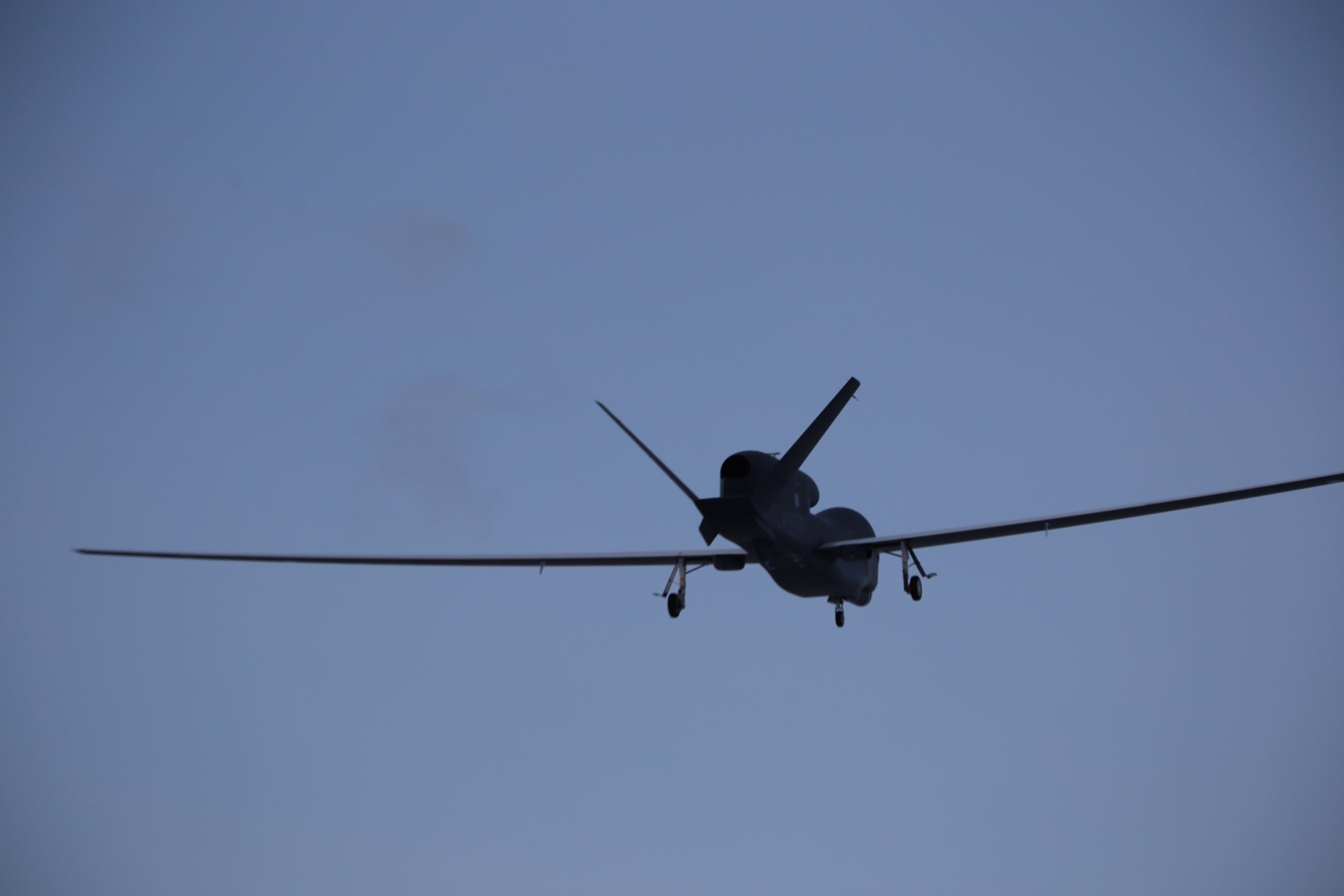The Japanese Air Self-Defense Force, or JASDF, has officially flown the first of its new RQ-4B Global Hawk surveillance drones that the country started the process of procuring from the United States in 2015. The high-altitude, long-endurance, or HALE, unmanned aerial vehicle is expected to strengthen Japan’s surveillance capabilities as the country explores ways to enhance its situational awareness and better deter and respond to attacks from outside forces like North Korea and China.
Designed by Northrop Grumman, the RQ-4’s maiden flight with the JASDF occurred on Dec. 21 at an undisclosed location. It took place eight months after Japan received its first Global Hawk in March after it flew itself over from the U.S. in an 18.7-hour transpacific flight. A year before that, Northrop Grumman held its first stateside flight test with Japan’s Global Hawk unmanned aerial vehicle (UAV) in April 2021 at its facility in Palmdale, California. Three total Global Hawks have been purchased by Japan under the State Department’s Foreign Military Sales program.

“[Global Hawks are being] introduced in order to conduct information gathering in areas relatively remote from Japan, as well as persistent airborne monitoring during situations with heightened tensions,” the JASDF said in a March statement.
The 2018 Defense Department contract awarded to Northrop Grumman for the three Global Hawks — all based on the Block 30 configuration — was worth $489.9 million. Each of the three Japanese variants of these UAVs has been designed with a synthetic aperture radar, infrared/electro-optical sensors, as well as signals-intelligence equipment. The overall order included two ground control systems and associated spares, operational flight test support, and communications equipment, among other support services.
Northrop Grumman’s Global Hawk is a very large UAV weighing 14,950 pounds (6,781 kilograms) that is designed to carry out intelligence, surveillance, and reconnaissance (ISR) operations. It can fly at an altitude of up to 65,000 feet and remain aloft for over 34 hours.

“The unarmed RQ-4B Global Hawk will provide Japan with on-demand intelligence, surveillance, and reconnaissance information supporting the Japan Air Self-Defense Force’s missions of protecting borders, monitoring threats, and providing humanitarian assistance in times of need,” said Jane Bishop, vice president and general manager of autonomous systems for Northrop Grumman, in an April 2021 press release.
The JASDF’s new fleet of Global Hawks will be housed at the service’s Misawa Air Base located in the northern part of Japan’s main island of Honshū. Beginning in 2014, the U.S. Air Force started stationing a number of its own Global Hawks at Misawa during the summer months after the season’s typhoons and thunderstorms hindered ISR operations with the UAV at Andersen Air Force Base in Guam. Since 2020, however, this transfer has been primarily occurring between Andersen and Yokota Air Base in Tokyo.
The JASDF has also launched a dedicated unit to operate Misawa’s new Global Hawks. The service’s new Air Reconnaissance Group began training with the U.S. Air Force’s 4th Reconnaissance Squadron out of Andersen in September to familiarize themselves with the procedures and protocol required to fly the UAVs.
The Global Hawks will ultimately integrate with other Japanese intelligence assets, “including ground-based command and control units,” according to Northrop Grumman. With its new fleet of Global Hawks, Japan will also join a list of allied operators of the Global Hawk family of UAVs in addition to the United States, which includes Australia, South Korea, and NATO member countries.
The Global Hawk will help Japan, a country made up of islands arrayed over a large area, to better monitor the approaches to its territory. It will also allow Japan to keep tabs on military activities and surveil large swaths of land by peering into other countries from international airspace. It could also eventually assist in Japan’s naval operations.
Global Hawk is defenseless and is operated using a semi-autonomous ‘desktop’ like ‘point-and-click’ interface. While it doesn’t have any value in terms of kinetic capabilities, the intelligence it provides could be critical in executing kinetic operations against an enemy.
The introduction of the Global Hawk to Japan’s reconnaissance operations also comes as the country is undergoing a significant shift in defense policy in response to the current geopolitical climate in the region. This was highlighted in Japan’s National Security Strategy, which explained that despite Article 9 of the Japanese Constitution saying that it should only act in self-defense, its ability to “make effective counterstrikes in an opponent’s territory” is nonetheless a “bare minimum self-defense measure.”
Japan’s Global Hawk fleet is also beginning operations as the United States is drastically reducing the size of its own fleet. Still, the RQ-4 gives Japan HALE capability, and a proven and mature system capable of this unique mission set.
Global Hawk will no doubt be a powerful contributor to Tokyo’s intelligence picture and that of its allies.
Contact the author: Emma@thewarzone.com
